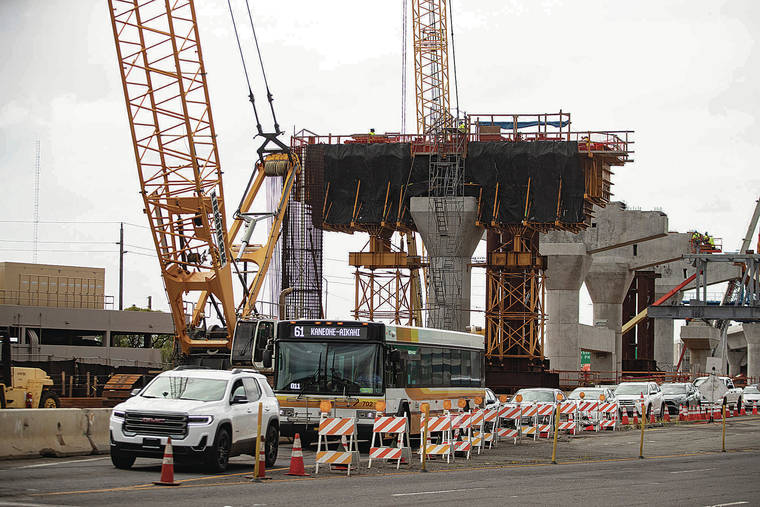Honolulu rail project faces $3 billion budget shortfall


CINDY ELLEN RUSSELL / CRUSSELL@STARADVERTISER.COM
Vehicles drove past rail construction on Dillingham Boulevard at Middle Street on March 1.


The city’s $11 billion rail project has a budget shortfall of $3 billion and the new interim CEO sees no clear path to plugging the deficit.
The money gap comes even as the Honolulu Authority for Rapid Transportation expects a $70 million infusion of federal COVID-19 relief funds to make up for HART’s 2020 drop in general excise and transient accommodations taxes, HART’s new interim CEO and executive director Lori Kahikina told the Honolulu Star-Advertiser’s Spotlight Hawaii online video program Wednesday.
The Federal Transit Administration extended HART’s deadline to come up with a financing plan from Dec. 31, 2020, to Dec. 31, 2021, for building and paying for the final leg of the 20-mile, 21-station project to Ala Moana Center.
A draft of HART’s response last week showed that “what we’re looking at is about a $3 billion shortfall,” Kahikina said. “It’s not all due to COVID. … The majority is the increase in cost and construction costs and how we do things. There’s a huge gap that we need to fill. … I don’t have the answers how to fix it.”
HART’s board knew that bids to build the final, 4-mile, eight-station segment to Ala Moana Center came in more than $1 billion over HART’s $1.4 billion budget. But board members have not been told by Kahikina that the project is $3 billion short and were surprised by her announcement Wednesday.
Two HART board committees are scheduled to meet today, including the project oversight committee, and the full board is scheduled to meet on March 18.
Don't miss out on what's happening!
Stay in touch with breaking news, as it happens, conveniently in your email inbox. It's FREE!
Kahikina, HART’s seventh leader since voters approved the transportation board’s concept in 2010, said she wants the job permanently.
From her first day at HART just over two months ago, Kahikina said she has identified inefficiencies and redundancies, canceled the contract for the problem-plagued route down congested Dillingham Boulevard and is planning unspecified job cuts to HART staff, consultants and contractors.
Kahikina expects to have all job decisions made by the end of the month but some already have been made.
“We seem to have multiple layers of consultants, contractors and our own staff doing review upon review so we’ve already cut some of our own staff, we’ve cut some of the high-paid consultants,” she said.
And she’s canceled the contract to build rail through Dillingham Boulevard, which is plagued by issues of burying utility lines in a tight corridor where HART does not yet have access to needed property.
The original $400 million Dillingham contract ballooned to $650 million so “I did stop that,” Kahikina said. “…. The way we contracted that project was not the correct vehicle to use.”
Instead of running rail’s overhead guideway straight down Dillingham Boulevard, Kahikina said the guideway is now planned for the mauka side, which will eliminate the need to put both makai and mauka Hawaiian Electric Co. power lines underground.
But the shift means that HART will have to work with the University of Hawaii and Kamehameha Schools for rights of way to use their land.
Making HART more efficient and cutting costs will not plug the $3 billion deficit, Kahikina said, but will hopefully make the rail project more attractive to getting more federal assistance, possible private support and give taxpayers greater confidence.
“I can’t possibly ask for additional funds if we’re not being prudent internally,” she said. “… People have a right to be skeptical and not trust HART. It’s a tall order for our new team to overcome.”
The entire project was supposed to be finished by January 2020.
“At the risk of being shot by the public and other stakeholders, we are actually estimating maybe 2031 that everything is complete,” Kahikina said.
Asked about her initial observations of HART, Kahikina said, “I do see quite a bit of redundancies and inefficiencies.”
She spoke of “layers upon layers — of whether it’s consultants, staff and the way we procure things with the contractors. It’s not the most efficient way. That’s the most surprising thing I’ve found here.”
But she repeated HART’s position that the project has to be built all the way to Ala Moana Center, the state’s busiest transit hub, and to fulfill its original funding agreement with the FTA.
“A lot of the feedback from the public is, ‘Just kill it. Just kill it at Middle Street,’” Kahikina said.
But ending rail earlier than planned would make it “a train to nowhere,” Kahikina said, while putting $800 million in federal funds in jeopardy.
“We have to make it,” she said, “we have to make it to Ala Moana.”



